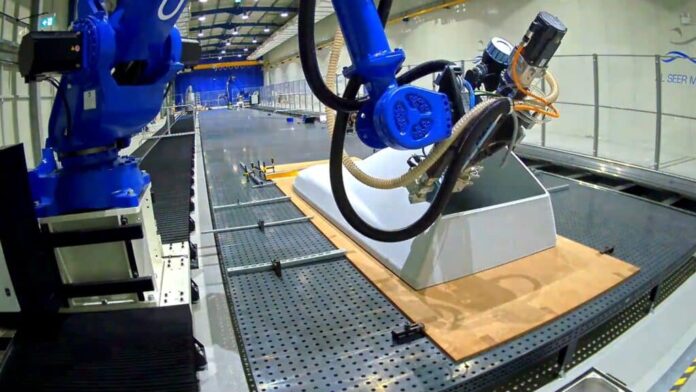Al Seer Marine, a maritime equipment manufacturer and services provider based in Abu Dhabi, recently introduced HYDRA, a 3D printed unmanned surface vessel (USV), or drone boat.
Described as a first of its kind, HYDRA is a concept vessel of 350 kg and 5m length produced using a composite-based system made by Dutch original equipment manufacturer (OEM) CEAD. The company’s robotic 3D printing capabilities have already been explored in the manufacture of ZEM, a partially 3D printed car that cleans the air while driving or the sustainable 3D Printed workspace R-Iglo.
As part of this project, the fabrication process took 5 days, in addition to the design and engineering work for the drone. Despite the fact that Al Seer Marine floated the drone prior to the exhibition and displayed the floating video on its booth, this is a technological demonstration platform, and the company is still developing the system to manufacture more drone parts with 3D printers. According to company representatives at the booth, they are working on a lighter USV that will be manufactured using a 3D printer.
According to Al Seer, the team will also 3D print an integrated mast for HYDRA. When the functioning vessel is completed, it will initially be used for intelligence, surveillance, and reconnaissance (ISR) missions.
The team also plans to manufacture large-scale additive manufacturing (LSAM) products and parts that are in high-demand regionally and globally.
The use of AM for Unmanned aerial vehicles (UAV)
Unmanned aerial vehicles (UAV) are gaining popularity due to their application in military, private and public sector, especially being attractive for fields where human operator is not required. According to a research, light-weight UAVs are more desirable as they have better performance in terms of shorter take-off range and longer flight endurance. However, light weight structures with complex inner features are hard to fabricate using conventional manufacturing methods. The ability to print complex inner structures directly without the need of a mould gives additive manufacturing (AM) an edge over conventional manufacturing. Recent development in composite and multi-material printing opens up new possibilities of printing lightweight structures and novel platforms like flapping wings with ease.
From a manufacturing standpoint, AM definitely seems to bring value where conventional manufacturing processes don’t. From a commercial and purpose standpoint, I doubt of the importance of every drone idea that would require the use of AM.
Source: Naval News. Remember, you can post job opportunities in the AM Industry on 3D ADEPT Media free of charge or look for a job via our job board. Make sure to follow us on our social networks and subscribe to our weekly newsletter : Facebook, Twitter, LinkedIn & Instagram ! If you want to be featured in the next issue of our digital magazine or if you hear a story that needs to be heard, make sure to send it to contact@3dadept.com


